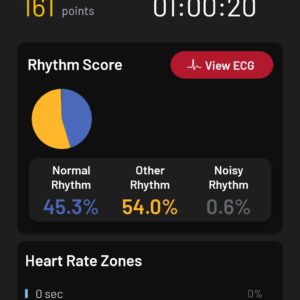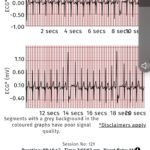-
This was today’s workout. Can someone please look at these and tell me if other rhythm , ecg,etc is good or bad.
-
-
Arthur, Thank you, thank you! Cardiologist will only look at his ekgs. No pain but I seem to feel some of the skipped beats. Going to keep riding bicycle and quit worrying so much. Thanks again.
-
There’s a challenge with getting the amount of information these devices generate. I don’t think Cardiologists are used to having to respond to so much data from their patients. And since my device is not an “approved” device, my doctor doesn’t necessarily trust it.
When they do ECGs with multiple leads they can see the activity in different parts of the heart and how the activities relate to each other at each point in time. So if they see something interesting on one trace (channel? IDK the correct word), they can look at other traces to see if there really is something there.
To me, one value of the device is to be able to run a trace when I’m feeling “something”. I had a few times when I thought my heart felt “funny, different” or was beating too fast or too hard for the activity I was doing. Trying to describe the symptoms when they are new to me, and not knowing the medical vocabulary, didn’t feel like I was communicating my concerns to my doctor effectively. Having a printout to share at my next regular doctor appointment helped the doctor understand the vocabulary I was using to describe my symptoms.
And I found that being significantly dehydrated can have a significant effect on my heart rate and possibly explained some irregular beats.
-
-
-
You’ve got some PVCs but what otherwise looks like NSR. PVCs are typically benign unless symptomatic, depending on age, health, and other cardiac risk factors. Don’t ever fail to bring them to the attention of your physician, though. In very rare cases, they’re the only expression of ischemia.
-
-




The 20-second interval displayed includes 3 “early “ beats. Is this representative of the other 200 +/- intervals? I think the 54% “other rhythm” means that % of the 20-second intervals have at least one deviation from the normal rhythm. Sometimes there is an inconsistent ECG (maybe associated with arm movements of some activities) that gets an “other rhythm” flag.
I see the other rhythm flag on intervals that have a single early (or skipped) beat. That’s a small % of the 15 to 50 beats in that interval (depending on heart rate).
Are there symptoms (pain, shortness of breath, feeling like an extra or skipped beat) associated with these intervals with early beats?
One or a few isolated different beats without other symptoms didn’t concern my cardiologist. They did make a notation when when I had a number close together within a short time. But nothing was done medically because I couldn’t reproduce it for the doctor on their medical-grade ECG with more leads connected.
I suggest looking at the other intervals in your workout to see what the representative interval would look like. Send pdfs of that chart interval and of the chart interval with the most interesting beats to your cardiologist along with a description of any symptoms and ask your doctor if you should be concerned.